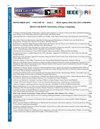Performance Enhancement of SWIPT by Utilizing the Distance Dependent Bandwidth of Underwater Channel for Cooperative NOMA based UASNs
IF 1.3
4区 工程技术
Q3 COMPUTER SCIENCE, INFORMATION SYSTEMS
引用次数: 0
Abstract
Underwater acoustic sensor networks (UASNs) support a variety of oceanic applications but suffer from limited communication bandwidth, reliability, and energy efficiency. Cooperative non-orthogonal multiple access (CNOMA) with simultaneous wireless information and power transfer (SWIPT) schemes are proposed for UASNs to meet these constraints. The unique characteristic of underwater acoustic channels compared to terrestrial wireless channels is the distance-dependent bandwidth, which provides additional bandwidth to the near user compared to the far user in NOMA-based UASNs. In this research work, we propose to enhance the performance of power splitting (PS) and time switching (TS) SWIPT schemes by utilizing this additional bandwidth at the near user in NOMA-based UASNs. We consider a CNOMA-based UASN and derive closed-form expressions for average achievable rates, energy efficiency, and outage probability with improved PS-SWIPT and TS-SWIPT schemes. From the analytical results, it is evident that the average achievable rate, energy efficiency and outage probability performances are significantly improved with the proposed methods. The analytical results are corroborated with extensive simulation studies.利用水下信道距离相关带宽增强基于协同NOMA的uasn的SWIPT性能
水声传感器网络(uasn)支持各种海洋应用,但受限于通信带宽、可靠性和能源效率。为了满足这些约束,提出了协同非正交多址(CNOMA)和同步无线信息和功率传输(SWIPT)方案。与地面无线信道相比,水声信道的独特特性是与距离相关的带宽,在基于noma的uasn中,它为近用户提供了比远用户更多的带宽。在这项研究工作中,我们提出通过在基于noma的usns中利用近用户处的额外带宽来提高功率分割(PS)和时间交换(TS) SWIPT方案的性能。我们考虑了一个基于cnoma的usasn,并推导了改进的PS-SWIPT和TS-SWIPT方案的平均可实现率、能源效率和停电概率的封闭表达式。分析结果表明,该方法显著提高了系统的平均可达率、能源效率和停电概率性能。分析结果得到了大量模拟研究的证实。
本文章由计算机程序翻译,如有差异,请以英文原文为准。
求助全文
约1分钟内获得全文
求助全文
来源期刊

IEEE Latin America Transactions
COMPUTER SCIENCE, INFORMATION SYSTEMS-ENGINEERING, ELECTRICAL & ELECTRONIC
CiteScore
3.50
自引率
7.70%
发文量
192
审稿时长
3-8 weeks
期刊介绍:
IEEE Latin America Transactions (IEEE LATAM) is an interdisciplinary journal focused on the dissemination of original and quality research papers / review articles in Spanish and Portuguese of emerging topics in three main areas: Computing, Electric Energy and Electronics. Some of the sub-areas of the journal are, but not limited to: Automatic control, communications, instrumentation, artificial intelligence, power and industrial electronics, fault diagnosis and detection, transportation electrification, internet of things, electrical machines, circuits and systems, biomedicine and biomedical / haptic applications, secure communications, robotics, sensors and actuators, computer networks, smart grids, among others.
 求助内容:
求助内容: 应助结果提醒方式:
应助结果提醒方式:


